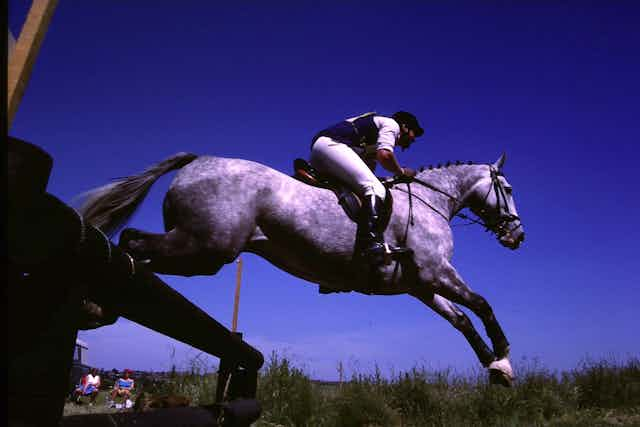The death of 17-year-old horse rider Olivia Inglis in March this year rocked the global equestrian world. The hashtag #rideforolivia went viral.
Not two months later, 19-year-old Caitlyn Fischer died in a similar event.
Both girls were experienced riders who specialised in eventing, which is an Olympic equestrian event in which Australian horses and riders excel internationally. It comprises three phases of competition: dressage, cross country and showjumping.
Both girls died on the cross-country course, from rotational falls. The cross-country phase is considered particularly dangerous as it involves galloping over solid obstacles on mixed terrain. Falls in this phase typically occur from height and at speed.
Where a horse clips a solid fence and falls rotationally, there is a risk of it falling on – and killing – the rider.
Wayne Roycroft, from the International Equestrian Federation, called them “freak occurrences”.
The tragedy of their deaths is undisputable. But just how risky is eventing, and horse riding in general?

Risks
One researcher documented rider deaths in all levels of eventing across the globe. She identified 59 confirmed rider deaths between 1993 and 2015. That is an estimated global average of 2.68 deaths per year from eventing.
A highly cited article, published in 1999, by Australian trauma specialist Dr Bruce Paix claimed that eventing was more dangerous than motorcycle or car racing. Paix found eventing 70 times more dangerous than horse riding in general and 180 times at the highest levels.
But can eventing be compared to other forms of horse riding, let alone motorcycle racing?
Paix’ calculations were made in relation to injury rates per time spent in the saddle. A recent critique suggests that risk is not evenly distributed across an eventing competition, hence the public popularity of the water jump.
Another way might be to look at injury rates per starter on the field. However, this data does not discriminate between falls on the flat and falls made at obstacles.
A recent critique by Denzil O'Brien suggests that a more accurate way to measure injury is to determine injury rates per jump attempt, as it is at jumps that horse and rider are at greatest risk of a rotational fall.
So eventing might not be more dangerous than motorcycle or car racing after all, but are event rider deaths “freak occurrences”?

Freak factor
In Australia alone, there are an estimated 20 deaths from horse-related injury every year. Compare this with an average of 1.7 deaths from shark attack. Every time a rider mounts a horse, there is a possibility they may fall off.
Every time a beachgoer swims in shark-infested waters, there is a risk that they are exposed to sharks. How “freak” then are these events?
This is not semantic quibbling over terminology. Freak events are usually considered the ones that could not have been prevented. Perhaps they could not even have been predicted.
The concern is that describing a horse-related death as a freak accident will lead to apathetic attitudes towards safety among those most at risk.
While the freak factor has been applied to motorcycle riders, base jumpers and rockclimbers, it is even more relevant for anyone sitting astride – or even handling – a half-tonne animal capable of running 50km/h and which has its own mind, teeth and hooves, and isn’t afraid to use them.
The risk of safety apathy among equestrians is further compounded by the widespread acceptance that horses are dangerous because they are inherently unpredictable herd animals, whose flight instinct is ever ready to kick in as their riders get kicked off.
Seeing horses as unpredictable is a risk factor for horse-related injury in itself. That is, if it activates complacency.
While no sentient being is fully predictable (humans included), a number of technical controls can be introduced to reduce the likelihood and consequence of an accident, injury or fatality.
But are we missing the point? Instead of talking about how unpredictable horses may or may not be, what if we spoke about how well humans can “read” and interpret horses? Can we improve human ability to predict horse behaviour?

There is a fine line between confident-aggressive, shy-afraid or quiet-sick, as any recipient of a dog bite or horse kick might know.
Animal scientists have developed some useful tools to help us talk to the animals. For example, researchers developed the Horse Grimace Scale to enable scoring of the equine pain face. It directs the assessor to pay detailed consideration to the horse’s ears, eyes, chewing muscles, chin and facial profile.
The chart has been adapted for popular circulation to help horse owners interpret their own horses. While interpreting the horse’s facial expression is far from a panacea for horse-related human fatality, it makes sense to accept that an unhappy or unwell horse is also a more unpredictable and less safe horse to be around.
Many an experienced rider or trainer who is particularly observant and attuned to horses will frequently claim “they could see something coming from a mile away”.
The question, though, should not be whether or not horses are unpredictable, but how we can better understand, interpret and pre-empt horse behaviour. In so doing, talking to the animals might actually be less of a freak occurrence than being injured by them.

